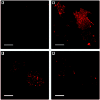Molecular mechanisms of the diabetogenic effects of arsenic: inhibition of insulin signaling by arsenite and methylarsonous acid
- PMID: 17520061
- PMCID: PMC1867998
- DOI: 10.1289/ehp.9867
Molecular mechanisms of the diabetogenic effects of arsenic: inhibition of insulin signaling by arsenite and methylarsonous acid
Abstract
Background: Increased prevalences of diabetes mellitus have been reported among individuals chronically exposed to inorganic arsenic (iAs). However, the mechanisms underlying the diabetogenic effects of iAs have not been characterized. We have previously shown that trivalent metabolites of iAs, arsenite (iAs(III)) and methylarsonous acid (MAs(III)) inhibit insulin-stimulated glucose uptake (ISGU) in 3T3-L1 adipocytes by suppressing the insulin-dependent phosphorylation of protein kinase B (PKB/Akt).
Objectives: Our goal was to identify the molecular mechanisms responsible for the suppression of PKB/Akt phosphorylation by iAs(III) and MAs(III).
Methods: The effects of iAs(III) and MAs(III) on components of the insulin-activated signal transduction pathway that regulate PKB/Akt phosphorylation were examined in 3T3-L1 adipocytes.
Results: Subtoxic concentrations of iAs(III) or MAs(III) had little or no effect on the activity of phosphatidylinositol 3-kinase (PI-3K), which synthesizes phosphatidylinositol-3,4,5-triphosphate (PIP(3)), or on phosphorylation of PTEN (phosphatase and tensin homolog deleted on chromosome ten), a PIP(3) phosphatase. Neither iAs(III) nor MAs(III) interfered with the phosphorylation of 3-phosphoinositide-dependent kinase-1 (PDK-1) located downstream from PI-3K. However, PDK-1 activity was inhibited by both iAs(III) and MAs(III). Consistent with these findings, PDK-1-catalyzed phosphorylation of PKB/Akt(Thr308) and PKB/Akt activity were suppressed in exposed cells. In addition, PKB/Akt(Ser473) phosphorylation, which is catalyzed by a putative PDK-2, was also suppressed. Notably, expression of constitutively active PKB/Akt restored the normal ISGU pattern in adipocytes treated with either iAs(III) or MAs(III).
Conclusions: These results suggest that inhibition of the PDK-1/PKB/Akt-mediated transduction step is the key mechanism for the inhibition of ISGU in adipocytes exposed to iAs(III) or MAs(III), and possibly for impaired glucose tolerance associated with human exposures to iAs.
Figures










Similar articles
-
Inhibition of insulin-dependent glucose uptake by trivalent arsenicals: possible mechanism of arsenic-induced diabetes.Toxicol Appl Pharmacol. 2004 Aug 1;198(3):424-33. doi: 10.1016/j.taap.2003.10.026. Toxicol Appl Pharmacol. 2004. PMID: 15276423
-
Regulation of phosphoinositide metabolism, Akt phosphorylation, and glucose transport by PTEN (phosphatase and tensin homolog deleted on chromosome 10) in 3T3-L1 adipocytes.Mol Endocrinol. 2001 Aug;15(8):1411-22. doi: 10.1210/mend.15.8.0684. Mol Endocrinol. 2001. PMID: 11463863
-
Membrane localization of 3-phosphoinositide-dependent protein kinase-1 stimulates activities of Akt and atypical protein kinase C but does not stimulate glucose transport and glycogen synthesis in 3T3-L1 adipocytes.J Biol Chem. 2002 Oct 11;277(41):38863-9. doi: 10.1074/jbc.M203132200. Epub 2002 Jul 29. J Biol Chem. 2002. PMID: 12147684
-
Insulin-sensitive phospholipid signaling systems and glucose transport. Update II.Exp Biol Med (Maywood). 2001 Apr;226(4):283-95. doi: 10.1177/153537020122600404. Exp Biol Med (Maywood). 2001. PMID: 11368419 Review.
-
Mechanism of protein kinase B activation by insulin/insulin-like growth factor-1 revealed by specific inhibitors of phosphoinositide 3-kinase--significance for diabetes and cancer.Pharmacol Ther. 1999 May-Jun;82(2-3):409-25. doi: 10.1016/s0163-7258(98)00071-0. Pharmacol Ther. 1999. PMID: 10454216 Review.
Cited by
-
Evaluation of the association between arsenic and diabetes: a National Toxicology Program workshop review.Environ Health Perspect. 2012 Dec;120(12):1658-70. doi: 10.1289/ehp.1104579. Epub 2012 Aug 10. Environ Health Perspect. 2012. PMID: 22889723 Free PMC article. Review.
-
Exposure to arsenic in drinking water is associated with increased prevalence of diabetes: a cross-sectional study in the Zimapán and Lagunera regions in Mexico.Environ Health. 2011 Aug 24;10:73. doi: 10.1186/1476-069X-10-73. Environ Health. 2011. PMID: 21864395 Free PMC article.
-
Origins, fate, and actions of methylated trivalent metabolites of inorganic arsenic: progress and prospects.Arch Toxicol. 2021 May;95(5):1547-1572. doi: 10.1007/s00204-021-03028-w. Epub 2021 Mar 26. Arch Toxicol. 2021. PMID: 33768354 Free PMC article. Review.
-
Metabolomic characteristics of arsenic-associated diabetes in a prospective cohort in Chihuahua, Mexico.Toxicol Sci. 2015 Apr;144(2):338-46. doi: 10.1093/toxsci/kfu318. Epub 2015 Jan 9. Toxicol Sci. 2015. PMID: 25577196 Free PMC article.
-
Association between type 2 diabetes and chronic arsenic exposure in drinking water: a cross sectional study in Bangladesh.Environ Health. 2012 Jun 7;11:38. doi: 10.1186/1476-069X-11-38. Environ Health. 2012. PMID: 22676249 Free PMC article.
References
-
- Alessi DR, Deak M, Casamayor A, Caudwell FB, Morrice N, Norman DG, et al. 3-Phosphoinositide-dependent protein kinase-1 (PDK1): structural and functional homology with the Drosophila DSTPK61 kinase. Curr Biol. 1997;7:776–789. - PubMed
-
- Altamirano MM, Libreros-Minotta CA, Lara-Lemus R, Calcagno M. Evidence for vicinal thiols and their functional role in glucosamine-6-phosphate deaminase from Escherichia coli. Arch Biochem Biophys. 1989;269:555–561. - PubMed
-
- Bazuine M, Carlotti F, Tafrechi RS, Hoeben RC, Maassen JA. Mitogen-activated protein kinase (MAPK) phosphatase-1 and -4 attenuate p38 MAPK during dexamethasone-induced insulin resistance in 3T3-L1 adipocytes. Mol Endocrinol. 2004;18:1697–1707. - PubMed
-
- Bazuine M, Ouwens DM, Gomes de Mesquita DS, Maassen JA. Arsenite stimulated glucose transport in 3T3-L1 adipocytes involves both Glut4 translocation and p38 MAPK activity. Eur J Biochem. 2003;270:3891–3903. - PubMed
Publication types
MeSH terms
Substances
Grants and funding
LinkOut - more resources
Full Text Sources
Medical
Molecular Biology Databases
Research Materials
Miscellaneous

